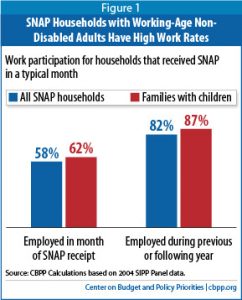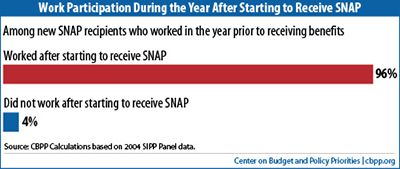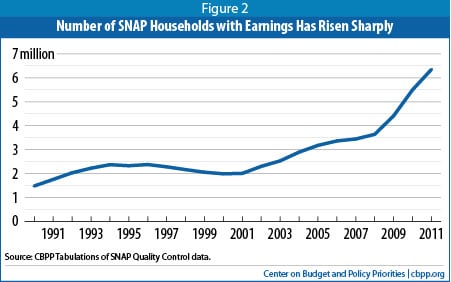
There is a lot of false information out there about food stamps and the people who receive them. It’s important to separate the common myths and misconceptions from the truth about food stamps — such as, just who are those 1 in 7 of our neighbors who rely on them?
Both federal and state legislators regularly try to place limits on the Supplemental Nutrition Assistance Program (SNAP, or “food stamps”). In recent years, these self-described “conservatives” have tried to cut food stamp funding and program access, every way possible and to shocking degrees. They propose rules to humiliate and demonize recipients of food stamps and other welfare programs, which they claim create a “culture of dependency.”
The fight continues to protect food assistance benefits as the first line of defense against both hunger and poverty. Therefore people must understand how the food stamps program works, who it helps, and how much it actually costs.
So let’s get to it.
Can anyone can get food stamps, settle back, and live high off the hog?
 You’ve likely heard stories (and outrage) about people using food stamps to purchase “steak and lobster” as well as cigarettes and alcohol, showing up at the grocery store in a nice car, nice clothes, a nice purse or an iPhone. But the federal government sets the food stamps benefit amount at, on average, roughly $4 a day per person.
You’ve likely heard stories (and outrage) about people using food stamps to purchase “steak and lobster” as well as cigarettes and alcohol, showing up at the grocery store in a nice car, nice clothes, a nice purse or an iPhone. But the federal government sets the food stamps benefit amount at, on average, roughly $4 a day per person.
Yes, someone could save up their monthly allotment to buy some high-priced food items for a special occasion. But they are likely eating rice and beans, peanut butter sandwiches – and going hungry – the rest of the month. (And you definitely can’t use food stamps to buy prepared foods or anything that’s not food.)
Many people fall into poverty after a job loss, losing a partner or spouse, or a major illness or accident. Or they were born into poverty and remained stuck there largely due to circumstances beyond their control. Either way, they will maintain appearances and hold onto any nice things they have for as long as they can. After all, they’re clearly being judged by those around them.
To receive food stamps you must be poor…
And you have to prove it. The U.S. Congress sets the rules and the funding for the SNAP/food stamps program, and then states administer it. To be eligible for food stamps your social security number is run through a number of government databases and you have to provide documents of your income and all your expenses.
Federal rules state that you can only be eligible for food stamps if your gross income (before taxes or deductions) is below 130% of federal poverty level guidelines, which determines what a livable income is based on household size. Under the federal policy of “categorical eligibility,” states can opt into higher income guidelines under certain circumstances, and more than 40 states do. In Pennsylvania, gross income can be up to 160% of the official poverty level, and 200% if a household member is elderly or disabled. (You can find the exact income guidelines here). However, Pres. Trump is trying to end states’ ability to let the near-poor access SNAP by terminating categorical eligibility, which will kick millions of Americans off food stamps.
Some people aren’t eligible for food stamps regardless of income, such as all undocumented immigrants, certain legal immigrants, and individuals who are on strike. Pres. Trump’s plan to end categorical eligibility will also force all states to require burdensome asset tests. States can also create their own eligibility measures, like barring from SNAP those who fail drug tests or people with prior criminal offenses.
And, if possible, you must be working.
In 1996, President Clinton and Congress put in place work requirements for unemployed food stamps recipients. Able-bodied adults age 18-49 and without dependents must work at least 20 hours a week to receive SNAP benefits. Alternatively, they must be engaged in job training, education, or community service for a certain number of hours each week. Otherwise they can only receive food stamps for 3 months in a 3-year period. High unemployment caused this rule to be suspended during the recent economic recession but is now back in place. (In Pennsylvania, the Wolf administration reinstated work requirements in most of the state on March 1, 2016. However, starting January 1, 2019, they waived the work requirement for much of PA, including Allegheny County. These waivers are renewed every year, so the areas which are waived may change again in 2020.)
Now that you know the basic rules (more info here on eligibility, what you can buy with food stamps, and how to apply), let’s address common complaints and questions about the food stamps program:
Should the U.S. be spending so much on food stamps?
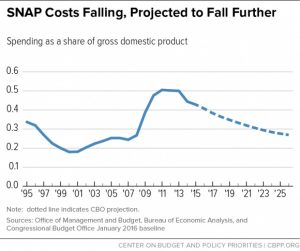 More than 80% of all SNAP/food stamp benefits go to households with a child, senior, or disabled person. Most food stamp recipients are children and the elderly. Why would we want to turn our backs on hungry people?
More than 80% of all SNAP/food stamp benefits go to households with a child, senior, or disabled person. Most food stamp recipients are children and the elderly. Why would we want to turn our backs on hungry people?- Meanwhile, defense spending is preposterously high, but federal officials justify that with the country’s ongoing military activity and wars. Shouldn’t there be a war on U.S. hunger and poverty?
- Food stamp spending is a tiny fraction of overall government spending—just over 2% in 2015. For comparison, we spent nearly 16% of the U.S. budget that year on the military, and nearly half of that went to private companies (who donate some of it back to the elected officials who defend their interests). In comparison, nearly all of SNAP spending (93%) goes directly to households to help them purchase food.
- The food stamps program is highly efficient in terms of bang for the tax-payers’ bucks: it reaches the majority of people who need it and helps lift 4.7 million people out of poverty (reducing child poverty by 3%), thereby reducing hunger’s enormous costs to society ($6 billion in Pennsylvania alone).
- The majority of Americans have consistently supported the food stamp program and think cutting it is the wrong way to reduce government spending.
In fact, we’re not spending enough on food stamps.
The need for food assistance is greater than food stamps can fill. Furthermore, the benefit amount is too low to allow a family to purchase an adequate, healthy diet.
- The average monthly food stamp benefit per person in 2018 was only $127, or less than $1.50 per person, per meal.
- SNAP does not cover the cost of a meal in 99% of all counties in the United States.
- Only 55% of food insecure individuals are income-eligible for food stamps. More than 1/4 of food insecure people (29%) are not income-eligible for any federal food assistance.
Food stamp spending is smart way to deal with hunger.
A 2015 Obama administration report found that SNAP’s numerous benefits are clear.
A growing body of high-quality research shows that SNAP is highly effective at reducing food insecurity, and in turn has important short-run and long-run benefits for low-income families. SNAP’s benefits are especially evident and wide-ranging for those who receive food assistance as children; they extend beyond the immediate goal of alleviating hunger and include improvements in short-run health and academic performance as well as in long-run health, educational attainment, and economic self-sufficiency.”
Additionally, spending on food assistance helps the economy more than any other stimulus spending. Federal government research shows $1 billion in SNAP benefits results in $1.5 billion in economic activity and creates 13,560 jobs.
It makes sense. SNAP dollars go to people living paycheck to paycheck. They immediately spend the benefits on food. For some, this leaves them more income to purchase other necessities, which boosts our economy and helps create jobs.
Why are so many people on food stamps?
Nearly 39.7 million Americans received food stamps in 2018. 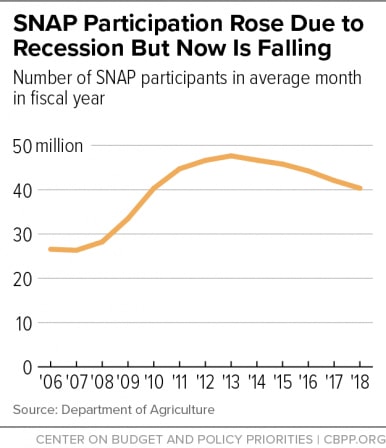 The federal government created food stamps as an entitlement program so that anyone who qualifies can immediately receive nutrition assistance. Funding for the program automatically expands based on need; this keeps people from starving during hard times.
The federal government created food stamps as an entitlement program so that anyone who qualifies can immediately receive nutrition assistance. Funding for the program automatically expands based on need; this keeps people from starving during hard times.
Not surprisingly, participation in SNAP/food stamps increased by 70% between 2007 and 2011 due to the economic recession. Conservative legislators complained at this time that food stamp spending had reached record highs. But this is exactly how the program is supposed to operate. When the economy recovers, as it did, SNAP spending falls.
But huge wealth gaps in this country remain; the U.S. economy doesn’t work for everyone. Income inequality is at levels not seen in nearly 100 years, and is still increasing. Some 40% of Americans couldn’t cover a $400 emergency expense, and one in four have no retirement savings. Wherever and whenever wages don’t keep up with the rising costs of living – which is of course nearly always the case for workers with low wages, unsteady income, and few benefits – food stamp participation will rise.
Food stamp recipients are not lazy or relying on welfare to get by.
The federal government designed SNAP benefits as short-term food assistance for the unemployed, or longer-term help for those who can’t work or aren’t earning enough. Decades ago, more food stamp recipients also received government cash assistance and few worked. But after the 1996 Welfare Reform Act remade welfare as Temporary Assistance for Needy Families (TANF) and turned the program over to the states, only a fraction of families in deep poverty who qualify for cash assistance receive it.
That year, another federal mandate was put in place to require food stamp recipients to work if they can. However, food stamps (unlike TANF) were already effective at supporting work:
For every additional dollar a SNAP recipient earns, her benefits decline by only 24 to 36 cents — much less than in most other programs. Families that receive SNAP thus have a strong incentive to work longer hours or to search for better-paying employment. States further support work through the SNAP Employment and Training program, which funds training and work activities for unemployed adults who receive SNAP.”
Yet as of 2016, 40 states had work requirements for food stamps in place, including the 22 states that suspended them during the high unemployment caused by the Great Recession.
Around 2/3 of food stamp recipients are not expected to work because they are senior citizens on a reduced income, people with disabilities, or children.
The remaining 1/3 of SNAP households have at least one working-age, non-disabled adult. Of these, more than half work while receiving SNAP — and more than 80% work in the year before or after receiving SNAP. The rates are even higher for families with children.
Unfortunately, a growing number of SNAP households are employed. They’re working but still can’t get by. These are households in which one of the two wage-earners lost their job or became disabled. Or they are among the increasing numbers of Americans who are in low-wage jobs or are not getting enough hours. The income of the working poor fails to cover rising rents, heating, health care, and other necessary expenses, including food.
The food stamp program is not full of waste, fraud, and abuse.
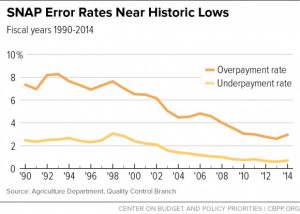 The U.S. Department of Agriculture (USDA), which oversees SNAP, takes food stamp fraud seriously. “SNAP’s Quality Control (QC) system earns a solid “A” grade. Over 99 percent of those receiving SNAP benefits are eligible,” it reports. Fraud had been steadily declining prior to this, with SNAP trafficking – people who sell food stamps for cash – at about 4 cents of every food stamp dollar in 1998. The current 1% fraud rate means SNAP benefits abuse amounted to roughly half a million dollars in 2019. That’s a drop in the bucket compared with the $125 billion the U.S. Department of Defense is wasting at last count, or the $334 billion it lost to contractor fraud between 2013-2017.
The U.S. Department of Agriculture (USDA), which oversees SNAP, takes food stamp fraud seriously. “SNAP’s Quality Control (QC) system earns a solid “A” grade. Over 99 percent of those receiving SNAP benefits are eligible,” it reports. Fraud had been steadily declining prior to this, with SNAP trafficking – people who sell food stamps for cash – at about 4 cents of every food stamp dollar in 1998. The current 1% fraud rate means SNAP benefits abuse amounted to roughly half a million dollars in 2019. That’s a drop in the bucket compared with the $125 billion the U.S. Department of Defense is wasting at last count, or the $334 billion it lost to contractor fraud between 2013-2017.
One could say, however, that it’s companies like WalMart and McDonald’s who are abusing welfare, turning food stamps and other assistance programs into a government subsidy for low wages. Companies make high profits by paying poverty-wages. But then it’s on government and taxpayers – including those employees – to make up the difference. (To the tune of $2.6 billion/year for WalMart and $1.2 billion/year for McDonalds.)
Why are cuts and restrictions to SNAP morally wrong?
There is broad public support for a strong safety net. Yet too many elected officials increasingly prioritize granting tax breaks for corporations and the wealthy. They then offset the huge loss in revenue by restricting programs that ensure basic standards of living.
Legislators shouldn’t balance government budgets on the backs of the tens of millions of working poor and vulnerable households. These folks are already struggling to get by. Nor should elected officials put up costly bureaucratic barriers to human services. These critical programs should not be needlessly hard or humiliating to access.
We need government investments and policies that allow all people to achieve their potential. And we must protect basic assistance programs like food stamps for those in times of need.
That is the solution to hunger.
As the world’s richest nation, we can certainly afford to end hunger. And we must, if we want our country to also be moral and truly strong.
Pushing government at all levels towards this goal is Just Harvest’s mission. Please join us.

